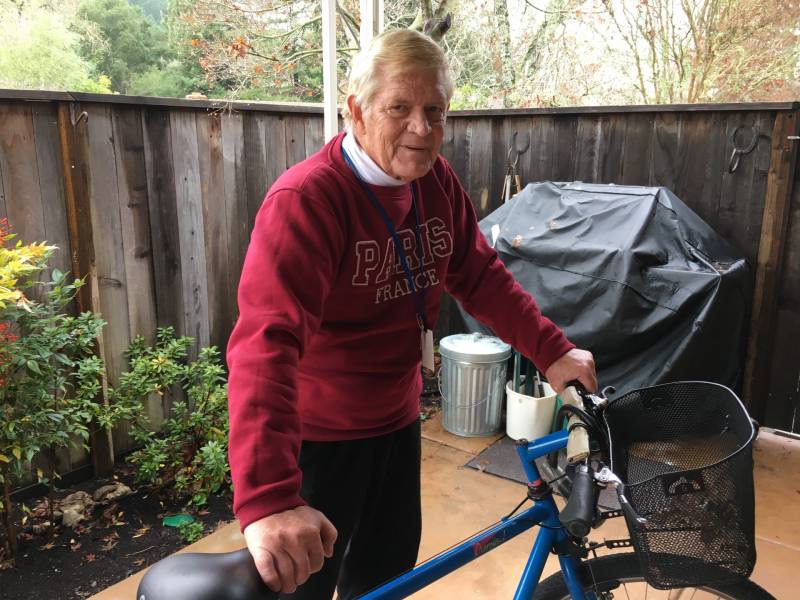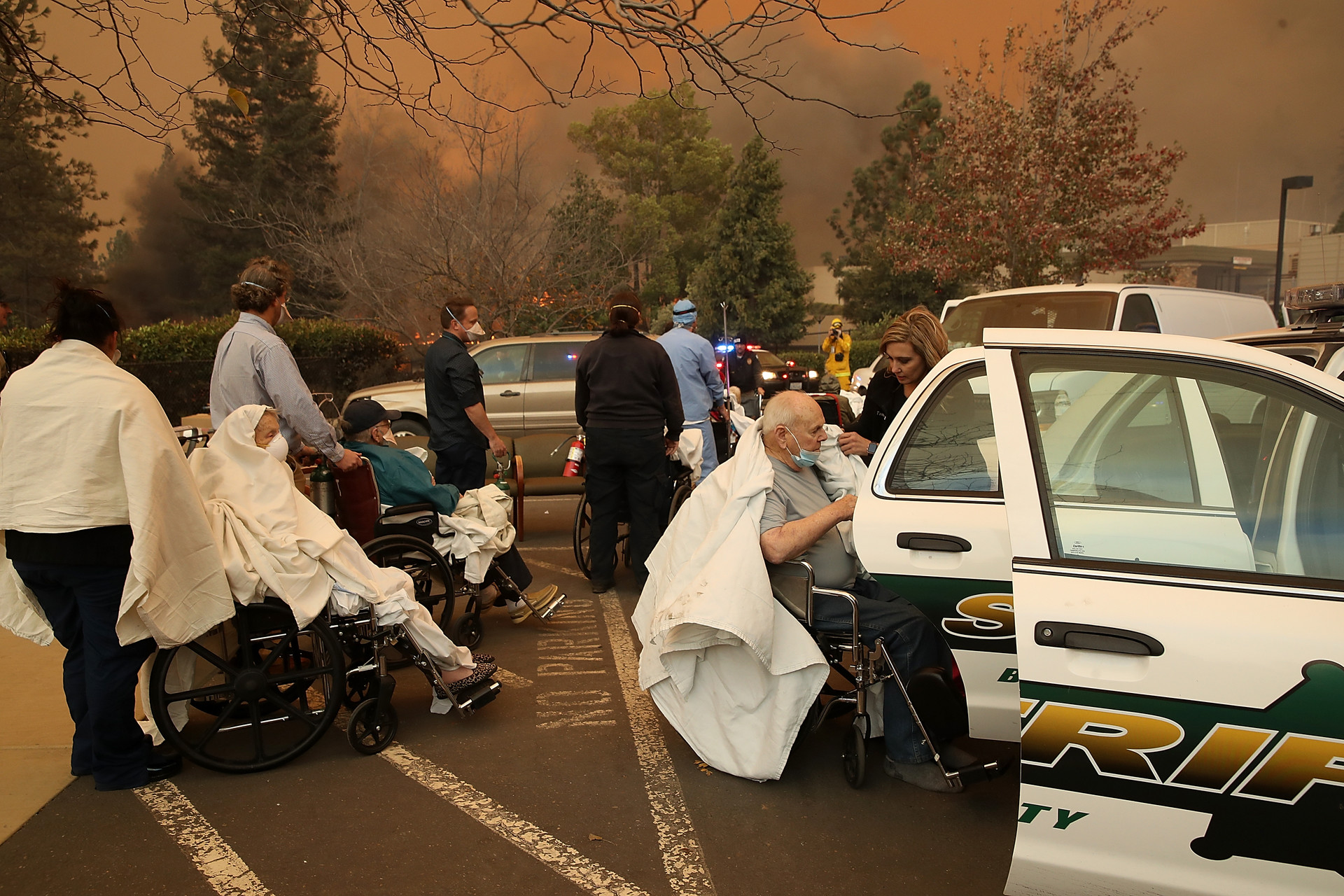Millions of Older Californians Live Where Wildfire Threatens. Mostly, They’re on Their Own
Description
The fire refugees kept calling, all of them elderly, all of them newly homeless after Paradise burned in 2018. Some 70 miles to the south in Grass Valley, Katrina Hardin answered those calls. Hardin managed a senior apartment complex — none were available, so she begged her friends to open up their spare rooms.
The demographics of the victims haunted her: About three-quarters of those who died in the Camp Fire were over the age of 65. Same with the fires that ravaged Sonoma and Napa the year before. Hardin fears for people in her own Nevada County, known as a haven for retirees, where 96% of the land is at heightened risk for wildfire.
“We’ve got all these elderly people — their sons and daughters may be living in Southern California, in the Bay Area, in another state,” Hardin said. “The elderly are living by themselves here with just their neighbors.”
Across the state, about 2 million people age 65 and older live in areas where wildfire is a serious threat, according to a KQED and CalMatters investigation.
But at the state and county level, no public agency has legal responsibility for ensuring that these older adults are able to evacuate in a disaster. The county response involves alerting residents of immediate danger and providing evacuation shelter, but not the evacuation in between.
Areas Prone to Fire
Credit: Lisa Pickoff-White/KQED and Lo Bénichou/CalMatters
Source: Cal Fire’s Fire Hazard Severity Zones, SILVIS lab at the University of Wisconsin Wildland Urban Interface and Natural Earth.
“There is no regulatory mandate for us to check on individuals,” said Tamaran Cook, former head of adult services and in-home health services for Nevada County. “There’s nothing statutory that’s consistent across all the counties in the state.”
The county has generally relied on aggressive outreach to help people with fire preparation — hosting informational meetings, sending newsletters. The county even produced a movie trailer that plays at the beginning of films in theaters, featuring people packing go bags and cleaning gutters. The county asks people not to overburden 911. Across formats the message is consistent: get yourself ready, because if a fire comes, you’re on your own.
Warning the Elderly Only Goes So Far
Last year, the state launched an effort focused on locating and warning people deemed especially vulnerable.
“You’re looking at seniors. You’re looking at people with disabilities. You’re looking at people in poverty. You’re looking at non-English-speakers,” said Karen Baker, the co-director of Listos, a program of the California Governor’s Office of Emergency Services.
In Sonoma, emergency managers facing growing public expectations after multiple fires have promoted new alert systems — including a NOAA weather radio that can shake the bed when someone’s sleeping.
Still, advocates say, the elderly are overrepresented in death counts after wildfires and during the current coronavirus pandemic, where nursing homes have been particularly hard hit.
“If these were children’s hospitals and children were dying like wildfire in them, there would be a very different community response than there is now,” said Debbie Toth, CEO of Choice in Aging, an advocacy group for seniors living independently. “Like, ‘These are just disposable people: They’re elderly, they’re at the end of their life anyway, there’s no value there.’”
Elderly People, in Particular, Suffer After Disasters
Disasters destabilize older adults, geographically, physically, financially and emotionally. Every bit of that happened to Jerry Canaday, 68, when he lost his home in the 2017 Tubbs Fire.
If rescuers came that night, Jerry Canaday slept through the knock at the door.
The noise of the fire woke him. “Like a storm,” he said. He walked out his door to see chunks of debris, in flames, falling heavy through the sky.
Canaday drove himself out of his Santa Rosa neighborhood, sleeping in his car that first night. Then he moved to an evacuation shelter set up at Finley Community Center. Weeks after the fire, some other men shook him awake in his cot when he almost stopped breathing. Doctors in the emergency room blamed the combined effects of smoke inhalation, pneumonia and heart failure.
<figure id="attachment_1968441" class="wp-caption aligncenter" style="max-width: 800px">
 <figcaption class="wp-caption-text">Jerry Canaday, 68, likes to say he’s going on 31, even after the Tubbs Fire took his money and his health. (Molly Peterson/KQED)</figcaption></figure>
<figcaption class="wp-caption-text">Jerry Canaday, 68, likes to say he’s going on 31, even after the Tubbs Fire took his money and his health. (Molly Peterson/KQED)</figcaption></figure>Canaday’s house was uninsured. After it burned to the ground, he called a FEMA trailer home for almost two years. He stayed longer than FEMA intended, because it was so hard to find a room to rent that he could afford.
“It’s another one of those, one step forward, 12 steps back,” he said.
Canaday’s new residence is in a risky area, by KQED’s analysis. He can no longer drive, his license suspended for medical reasons.
“I feel isolated,” Canaday said. “I don’t feel connected so much as I’d like to.”
Last fall, evacuation orders forced Canaday from his latest home when the Kincade Fire threatened Santa Rosa. Even his cat, Gigi, is a refugee from the Camp Fire in Butte County — a constant reminder of their shared survival, and risk.
“Just when you think you’re safe and nothing’s going to happen,” he said, “here it comes again.”
Californians don’t like being told where to live, even after a disaster.
That’s why we have to learn to live with wildfire and adapt to the increasing risks brought by climate change, says Max Moritz, a UC Cooperative Extension wildfire specialist.
“To finally come to a coexistence with wildfire: that is a whole different way of thinking and living with a given hazard,” he said. “It means that we have to be ready for them and we have to look out for the most vulnerable people when they do come.”
Building a Community to Save One
Rosemarie Reeder and her neighbors have decided to develop a buddy system to look out for the most vulnerable among them. Nevada County has one of the highest rates of residents over 65 in the state: 24.4 compared to the statewide average of 16.5, according to the U.S. Census Bureau data.
“It’s a lot of retirement up here,” she said. “Various people have walkers, some are in wheelchairs.”
<figure id="attachment_1968442" class="wp-caption aligncenter" style="max-width: 800px"><img decoding="async" loading="lazy" class="size-medium wp-image-1968442" src="https://ww2.kqed.org/app/uploads/sites/35/2020/08/RS41369_IMG_4708-qut-800x600.jpeg" alt="Rosemarie Reeder (left) and Katrina Hardin (right) in Grass Valley during December 2019." width="800" height="600" srcset="https://ww2.kqed.org/app/uploads/sites/35/2020/08/RS41369_IMG_4708-qut-800x600.jpeg 800w, https://ww2.kqed.org/app/uploads/sites/35/2020/08/RS41369_IMG_4708-qut-1020x765.jpeg 1020w, https://ww2.kqed.org/app/uploads/sites/35/2020/08/RS41369_IMG_4708-qut-160x120.jpeg 160w, https://ww2.kqed.org/app/uploads/sites/35/2020/08/RS41369_IMG_4708-qut-768x576.jpeg 768w, https://ww2.kqed.org/app/uploads/sites/35/2020/08/RS41369_IMG_4708-qut-1536x






